Eastern Redbud (Cercis canadensis): Leaves, Flowers, Bark (With Pictures) – Identification Guide

The Eastern Redbud (Cercis canadensis) is a decorative tree with heart-shaped leaves and striking pink to purplish spring flowers. Native to eastern North America, the small to medium-sized tree is highly versatile and enhances garden landscapes. Its ornamental features make the eastern redbud tree a popular ornamental tree for landscaping gardens.
This article is a guide to identifying features of eastern redbud trees. Pictures and descriptions of the pink-flowering redbud tree and its cultivars will help you decide how to use it in your landscape.
What is the Eastern Redbud Tree (Cercis canadensis)
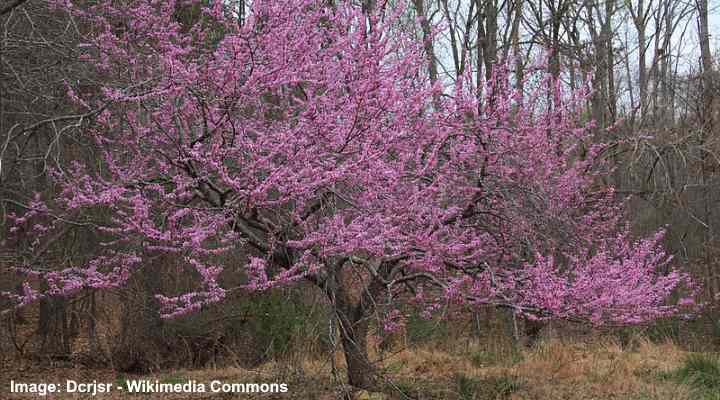
The eastern redbud tree is a multi-trunked, pink-flowering shrub or small tree in the genus Cercis. The tree has a graceful, spreading habit, and its horizontally arranged branches form a round canopy. The deciduous native tree blooms early in spring, with pink flowers appearing before the heart-shaped leaves.
The eastern redbud tree is the state tree of Oklahoma. It thrives throughout the Sooner State, enhancing garden landscapes, parks, and streets with its magnificent, vibrant magenta blooms in spring. The Cercis canadensis symbolizes the arrival of spring, and its bright flowers are said to “evoke a message of love from Oklahoma.”
Eastern redbud trees are suitable for growing in USDA zones 4 to 9.
Identifying Eastern Redbud Tree
Identifying the Eastern Redbud (Cercis canadensis) is relatively easy due to its early spring pink flowers on bare branches. You can also examine the leaf shape, which is like a heart dangling on long petioles. It also has smooth, grayish-brown bark covering heavy, hard, close-grained wood.
Let’s look in detail at the identifying features of the eastern redbud tree.
Eastern Redbud Tree Bark
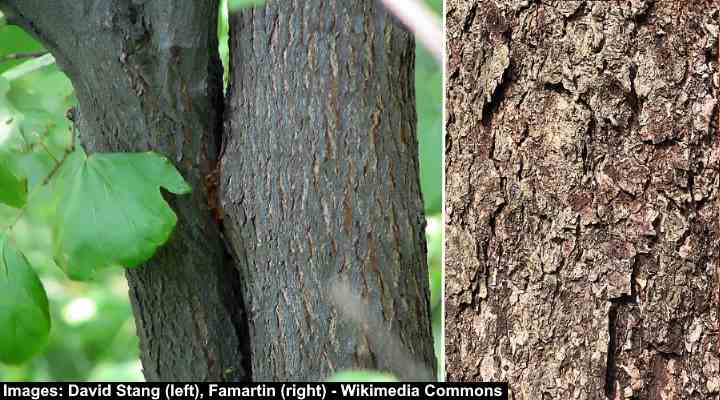
Examples of eastern redbud bark
The bark of the Eastern Redbud is reddish-brown, sometimes a grayish color that starts smooth. As the tree matures, the red-brown bark develops deeper fissures and a scaly texture. The gap between the fissures reveals a cinnamon-orange underbark. The small tree’s bark has a lustrous brown hue and becomes darker over time.
Eastern Redbud Flowers
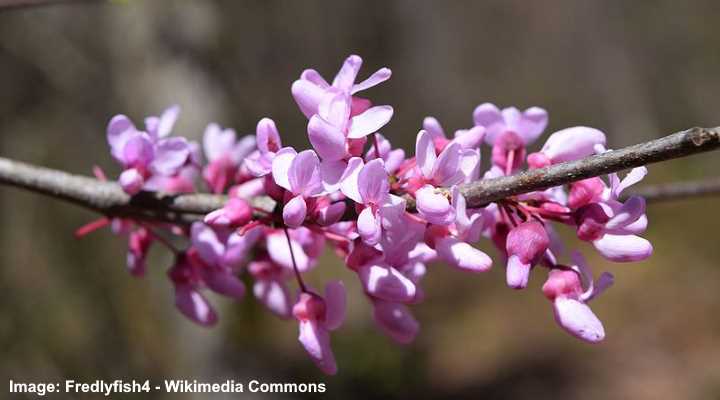
A close up picture of Eastern redbud flowers
Flowers on eastern redbuds are striking and distinctive, adding color to early spring landscapes. Redbud pinkish-purple, pink, or magenta flowers emerge from pink buds and bloom profusely to cover bare branches in a mass of color. Each flower has five petals forming pea-like blossoms, creating a dramatic rosy-pink floral display.
Eastern redbud flowers have a delicate and sweet fragrance. The mild, subtle aroma adds a pleasant element to the visual beauty of the tree when blooming throughout spring.
Redbud flowers are highly attractive to pollinators, including honeybees, butterflies, and hummingbirds. The vibrant pink color of the tree’s flowers and their pea-like shape make them easily visible to pollinators. The nectar-rich flowers are a vital food source early in the season. Therefore, planting eastern redbud trees helps contribute to biodiversity in your garden’s ecosystem.
Eastern Redbud Leaves

The leaves of eastern redbud trees are an easily identifiable heart shape. The leaves are cordate (shaped like a heart) and measure 2” to 5” (5 – 13 cm) long. Mature redbud leaves have a smooth texture and are dark green above with paler undersides. The simple leaves grow alternately on branches.
The fall color of eastern redbuds is bright golden yellow. The bright yellow leaves contrasting with the dark bark create eye-catching autumn scenery. After the deciduous leaves drop, the attractive branching habit adds visual appeal to winter landscapes.
Eastern Redbud Seedpods
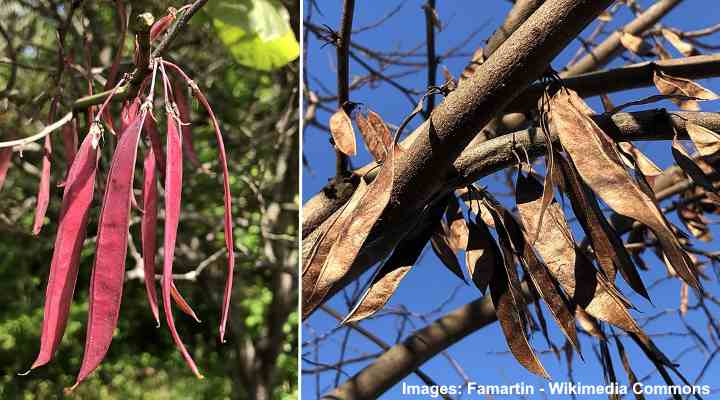
Eastern redbud seed pods: immature (left) and mature (right)
Eastern redbud trees have long, flat, brown seedpods. Being a member of the legume family, redbuds produce flattened pods containing four to ten bean-like seeds, each 0.25” (0.6 cm) long. The brown pods measure 2” to 4” (5 – 10 cm) long and appear after flowers finish blooming in summer.
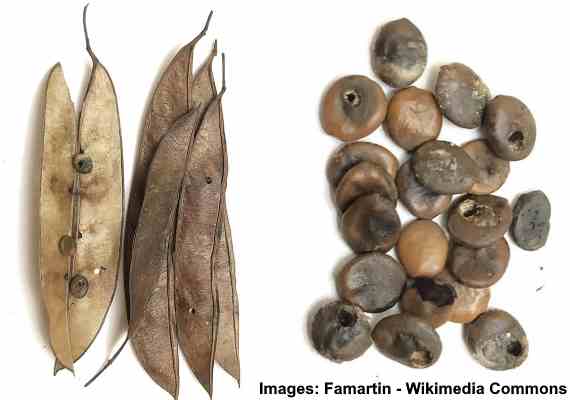
Eastern redbud seeds
Eastern redbud seedpods persist on the small decorative trees through fall and into winter. The brown-copper or reddish-burgundy leguminous pods are a crucial source of food for songbirds in late fall and winter. Unfortunately, the numerous seedpods make eastern redbuds somewhat messy trees when they drop.
Mature Height of Eastern Redbud
Eastern redbuds grow as large shrubs or small multi-stemmed trees. They reach a height of 20 to 30 ft. (6 – 9 m) and a width of 25 to 35 ft. (7.5 – 10.5 m). The branches grow in a horizontal pattern and form a rounded crown when mature.
Over time, mature redbud trees develop a crooked trunk and zig-zag branches.
Eastern Redbud Habitat
Eastern redbud trees thrive in a diverse range of habitats across eastern North America. You can find them growing in open woodlands, along forest edges, and in fertile soils with good drainage. These adaptable flowering trees enhance landscapes, adding beauty to a variety of environments.
Eastern redbuds have several landscaping uses, depending on your preferences and the size of your outdoor space. The vibrant pink flowers add beauty to shrub borders and front yards and enhance the beauty of backyard landscapes. You can also plant a redbud near patios or pathways or grow it as a lawn tree.
Eastern Redbud Growth Rate
The eastern redbud is a moderate to fast-growing tree. In optimal conditions, it grows at a rate of 4 to 6 ft. (1.2 – 1.8 m) per year during its early years. After five years, its growth rate slows to 2 to 3 ft. (0.6 – 0.9 m) annually.
Factors influencing growth include soil quality, sunlight exposure, and water availability. With proper care, eastern redbuds develop a well-branched canopy and reach their mature height within a relatively short timeframe. Their rapid growth makes them popular landscaping trees.
Eastern Redbud Tree Care Requirements
Eastern redbud trees are versatile trees that thrive with minimal care. The best flowering occurs in full sun when the tree grows in moist, well-drained soil. Although it tolerates some drought, it requires regular watering to thrive. Regular pruning and watering will ensure vigorous growth.
Let’s look in more detail at how to grow an eastern redbud in your garden landscape.
Soil for Eastern Redbud
Eastern redbud trees thrive in well-draining soil and tolerate slightly acidic, neutral, or alkaline soils. They also perform well in loamy or sandy soils. The most important care factor is to keep the soil consistently moist. Ensuring good drainage prevents waterlogging, promoting root health and healthy blooms and foliage.
Sunlight Requirements for Eastern Redbud
Eastern Redbuds prefer full to partial sunlight. The best location to plant a redbud is where it receives at least six hours of sunlight daily. While it can tolerate some shade, optimum flowering and growth occur in sunnier conditions. Some afternoon shade is necessary when growing in USDA Zone 9.
Watering Eastern Redbud
It’s necessary to water eastern redbud trees regularly, especially to establish a newly planted tree. For established redbuds, water the tree deeply when the 2” to 3” of the topsoil is dry. A typical watering schedule is to provide 1” (2.5 cm) of water weekly.
You may need to increase the watering frequency during hot, dry spells. However, ensuring the tree’s roots are never waterlogged is vital. Additionally, mulching around the base helps retain moisture, regulates soil temperature, and suppresses weeds.
Fertilizer for Eastern Redbud
Eastern redbuds generally do well without excessive fertilization. Like many leguminous plants, the tree is a nitrogen fixer and tends to do well without additional nutrients. However, a balanced, slow-release fertilizer in early spring can promote healthy growth. A suitable liquid fertilizer for redbuds is a multi-purpose one with an NPK rating of 10-10-10.
Some gardeners suggest applying organic compost or a slow-release 5-10-5 granular fertilizer in the spring. A higher ratio of phosphorus encourages root growth and flowering. However, avoid over-fertilizing, as it may lead to excessive foliage at the expense of flowers. Follow recommended dosage guidelines for the specific fertilizer used.
Pruning Eastern Redbud Trees
The best time to prune redbud trees is in late winter or early spring for general maintenance and to remove dead or diseased branches. If you want to enjoy the full spring bloom, prune immediately after the flowering season ends.
Pruning an eastern redbud tree helps improve air circulation, removes dead or damaged branches, and encourages vigorous growth. You should remove branches crossing or growing toward the center. After that, thin out overly long branches.
Best Eastern Redbud Upright Tree Varieties
Redbud trees are some of the most beautiful ornamental trees for spring blooms. Here are some examples of attractive redbuds with upright growth habits.
Eastern Redbud ‘Hearts of Gold’ (Cercis canadensis ‘Hearts of Gold’): This attractive eastern redbud variety has eye-catching golden foliage, lavender-purple, pea-like flowers, and heart-shaped leaves. Its foliage fall colors are golden yellow. With its upright growth and dome-shaped canopy, the redbud grows 20 to 25 ft. (6 – 7.6 m) tall and 18 ft. (5.4 m) wide.
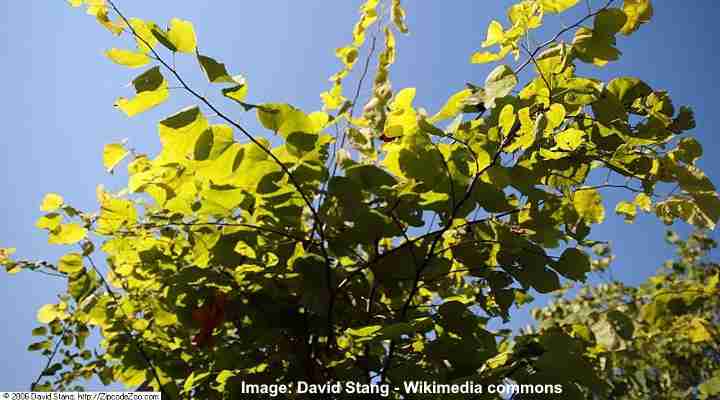
Cercis canadensis ‘Hearts of Gold’ tree
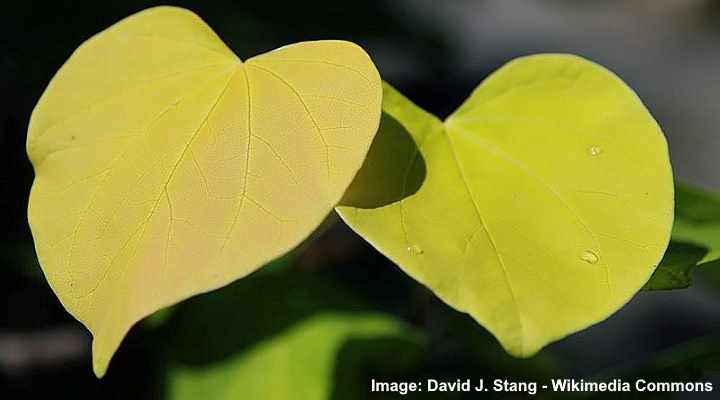
Redbud Cercis canadensis ‘Hearts of Gold’ leaves
White Eastern Redbud (Cercis canadensis f. alba): Prized for its showy white flowers, this upright eastern redbud variety has a vase shape and early spring blooms. The masses of pea-like flowers cover bare branches before heart-shaped, blue-green leaves develop. It grows 20 to 30 ft. (6 – 9 m) tall and up to 35 ft. (10.5 m) wide.
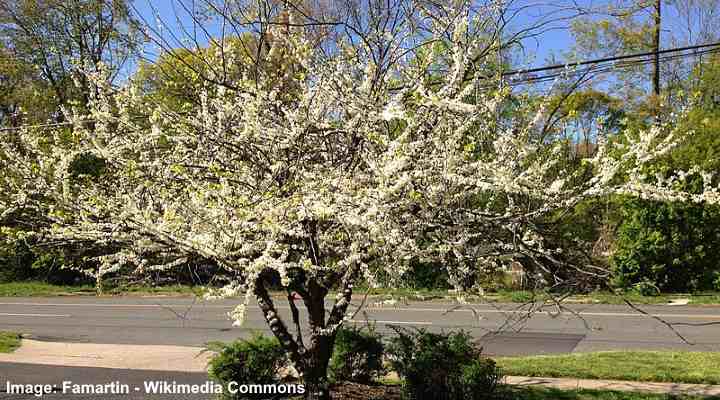
Cercis canadensis f. alba
Eastern Redbud ‘Forest Pansy’ (Cercis canadensis ‘Forest Pansy’): This spectacular eastern redbud has rosy-pink flowers blooming in early spring. Its heart-shaped leaves are reddish-purple, creating a dramatic statement in landscapes. Its foliage turns bronze, orange, and red-purple shades in the fall. This redbud cultivar grows 30 ft. (9 m) tall and 35 ft. (10.5 m) wide.

Cercis canadensis ‘Forest Pansy’
Eastern Redbud ‘Burgundy Hearts’ (Cercis canadensis ‘Burgundy Hearts’): It’s one of the most spectacular redbud varieties. The striking ornamental tree has red-purple heart-shaped leaves that turn yellow in the fall. It has pea-like lavender flowers that bloom for several weeks on bare branches. The redbud grows 20 ft. (6 m) tall and 25 ft. (7.6 m) wide.
Texas Redbud (Cercis canadensis var. texensis): This small tree native to Texas is prized for its dark wine-red flowers, glossy green cordate leaves, and flattened seedpods growing 4” (10 cm) long. The fragrant, nectar-rich flowers attract pollinators early in the season. Expect the Texas redbud to grow 30 ft. (9 m) tall and 25 ft. (7.6 m) wide.

Texas Redbud (Cercis canadensis var. texensis)
Eastern Redbud ‘Tennessee Pink’ (Cercis canadensis ‘Tennessee Pink’): This small redbud grows only 15 to 20 ft. (4.5 – 6 m) tall. The flowering ornamental tree has early-blooming pink flowers blooming in dense clusters. Its heart-shaped green leaves turn yellow shades before dropping.
Eastern Redbud Flame Thrower (Cercis canadensis ‘Flame Thrower’): This redbud cultivar is identified by its masses of dark pink, pea-like flowers, and glossy red, heart-shaped leaves. Its fall color is various shades of orange, and its leaves drop to reveal long, flattened seedpods. The ornamental tree grows 15 to 20 ft. (4.5 – 6 m) tall and 15 ft. (4.5 m) wide.
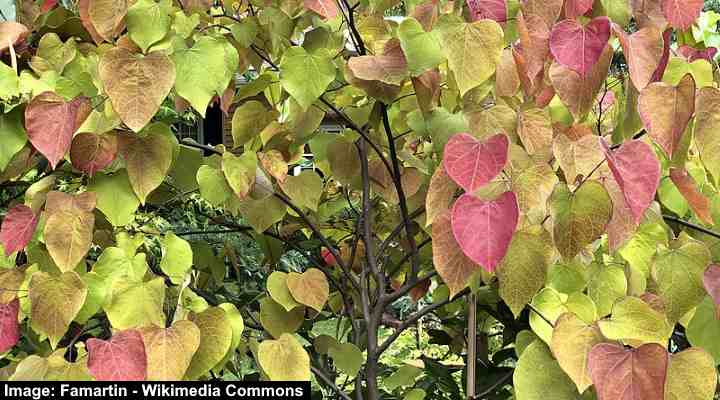
Cercis canadensis ‘Flame Thrower’
Eastern Redbud ‘Carolina Sweetheart’ (Cercis canadensis’ Carolina Sweetheart’): This unusual redbud cultivar has heart-shaped variegated leaves that emerge purple-maroon and hot pink before turning green with white edges. Its beautiful flowers are pink-purple. The beautiful redbud tree grows up to 25 ft. (7.6 m) tall and 20 ft. (6 m) wide.
Eastern Redbud Weeping Trees
Are you looking to add spectacular landscaping features to your front yard? In that case, eastern redbud trees with cascading branches are your answer. Here are two outstanding redbud trees with a weeping growth habit.
Eastern Redbud ‘Lavender Twist’ (Cercis canadensis ‘Lavender Twist’): This ornamental dwarf tree has cascading branches, creating a dramatic floral display of pink shades in spring. The weeping redbud has heart-shaped green leaves that turn golden yellow in the fall. This redbud grows 6 ft. (1.8 m) tall and up to 8 ft. (2.4 m) wide.

Eastern redbud ‘Lavender Twist’
Eastern Redbud’ Ruby Falls’ (Cercis canadensis’ Ruby Falls’): Noted for its weeping habit, this redbud variety has dark maroon-red leaves in a heart shape. Like all redbuds, it transforms bare spring landscapes when blooming with dark rose pea-like flowers in early spring. It grows up to 6 ft. (1.8 m) tall and 4 ft. (1.2 m) wide.
Read more: Beautiful Types of Redbud Trees
Landscape Uses for Ornamental Eastern Redbud Trees
Eastern redbud trees are prized in landscaping for their ornamental value. Their early spring blooms and attractive fall foliage colors add vibrant colors to landscapes. In moist, well-draining soils, they perform well as lawn trees, accent plants, and container plants on patios.
Depending on the tree size, you can grow ornamental redbud trees as foundation plantings, privacy screens, or barriers.
Eastern Redbud Care Problems
Common diseases affecting eastern redbuds include leaf spots (Anthracnose), canker and dieback (Botryosphaeria ribis), and verticillium wilt (Verticillium albo-atrum and Verticillium dahliae). Typically, careful pruning, proper fertilization, and deep watering of the roots can avoid most disease issues.
Insects and wildlife can also affect eastern redbud trees. For example, mealybugs, leafhoppers, aphids, and Japanese beetles can feed on foliage. Also, caterpillars can be occasional pests by destroying the attractive leaves. It’s good to note that deer and rabbits are attracted to the tree’s leaves.
FAQs — Eastern Redbud Tree
Why is my eastern redbud not blooming?
If your Eastern Redbud isn’t blooming, it could be due to several key factors. Firstly, consider the age of the tree; Redbuds typically start flowering at 4 to 7 years old. The amount of sunlight is crucial, as these trees need full sun to partial shade to bloom effectively.
Incorrect pruning can also impact flowering; redbud trees bloom on old wood, so prune after they have flowered to enjoy flowering in the next season. Nutrient imbalances, particularly from over-fertilization with nitrogen-rich fertilizers, can lead to excessive leaf growth at the expense of flowers.
Watering is another critical aspect; both overwatering and underwatering can stress the tree and impede blooming.
Diseases and pest infestations can affect the tree’s health, thereby reducing flowering. Weather conditions, such as late frosts, can damage the buds, while soil conditions, like poor or compacted soil, can limit growth and flowering.
Finally, genetic factors play a role; some redbud varieties naturally bloom less frequently than others.
How close to the house can you plant a redbud tree?
Eastern redbud trees should be planted at least 8 to 10 ft. (1.8 – 3 m) away from structures like houses. However, for larger redbuds, it’s vital to consider the canopy size of the mature tree. Redbuds have a shallow, spreading root system that can affect foundations as they mature.
Do redbud trees have invasive roots?
Redbud trees typically have a shallow, non-invasive root system. Their roots are not known to cause significant problems with structures or underground pipes. The roots typically reach depths of 3 to 4 ft. (0.9 – 1.2). However, to be safe, leave a gap of 6 to 8 ft. (1.8 – 2.4 m) between the tree and sidewalks or driveways.
Can eastern redbud trees be grown in containers?
Eastern redbuds are the most suited of all the redbud varieties to container planting. The attractive spring flowers, lush summer foliage, and eye-catching fall colors add vibrancy and texture to patios and decking areas. Choose a suitable container at least 18” (45 cm) wide and 24” (60 cm) deep.
The best types of redbuds for growing in planters are dwarf varieties. Generally, you can expect a redbud planted in a container to be half the size of one growing in the ground.
Are eastern redbud trees suitable for small gardens or yards?
Eastern Redbud trees are excellent choices for small gardens or yards. Their compact size, aesthetic appeal, and adaptability make them ideal for limited spaces or tight corners. Ideally, it’s best to choose a dwarf eastern redbud or weeping variety to enjoy their ornamental value without overwhelming smaller landscapes.
Pros and Cons of Planting Redbud Trees
Redbud trees are cherished for their spectacular pink blossoms that emerge in early spring, offering a stunning visual treat. They are particularly suitable for small spaces due to their modest size, making them ideal for urban gardens and areas with limited space, such as under power lines.
Additionally, these trees are known to attract a variety of pollinators, including bees and butterflies, which contributes to enhancing local biodiversity. Redbuds are also appreciated for their drought tolerance once fully established and their ability to adapt to various soil conditions, though they do prefer well-drained soils.
However, redbud trees do have some drawbacks, such as a relatively short lifespan, typically ranging from 20 to 30 years. They are susceptible to diseases like canker and verticillium wilt and are prone to pest infestations, including tree borers and leafhoppers.
Another consideration is their brittle wood, which may lead to branch breakage during storms or under the weight of heavy snow. Finally, the falling flowers, seed pods, and leaves can create a mess on lawns and driveways, requiring regular cleanup.
Therefore, while redbud trees are a beautiful addition to any landscape, they require careful consideration of these factors for optimal growth and maintenance.
Related articles:
